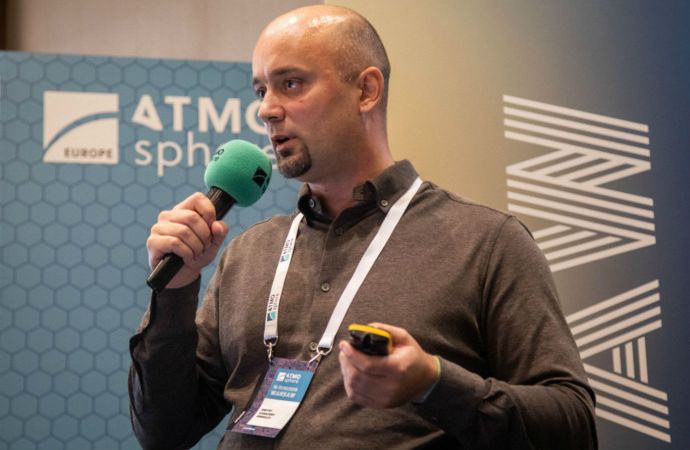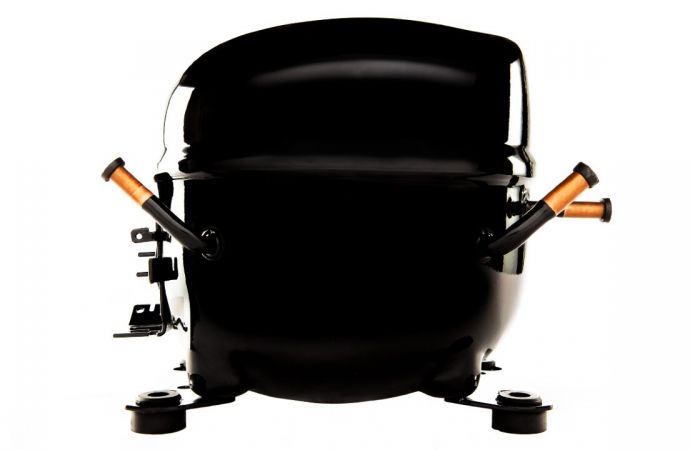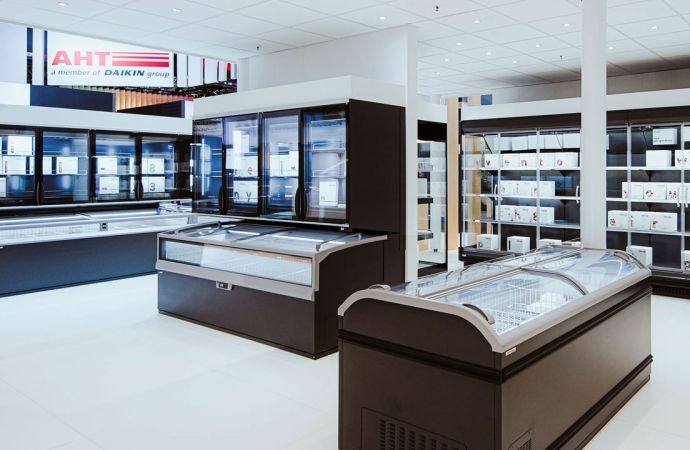A Verny convenience store is using Embraco’s Plug n’ Cool modular units in self-contained cases instead of R404A remote condensing units.

Dmitry Kamadeev, Embraco, at ATMOsphere Europe in Warsaw, Poland
Verny, a Russian convenience-store chain with more than 520 stores, has installed propane (R290) modular refrigeration units in self-contained cases in a new store that have reduced energy costs by 34% compared to the R404A remote condensing units used at other stores.
The Verny store’s pilot of an R290 modular unit – the Plug n’ Cool from Embraco, a division of Nidec – was the subject of a presentation by Dmitry Kamadeev, Sales Manager, Europe Region, for Embraco, at the ATMOsphere Europe conference in Warsaw, Poland, held October 16-17. He shared the stage with Dmitry Barsukov, head of sales for Cryspi, the Russian display-case OEM for the project.
Russia is a conservative market that favors remote R404A condensing units in convenience stores, and is not pushed by regulations to change, noted Kamadeev. “But Cryspi wanted to pioneer natural refrigerants in order to save energy.” The end user, Verny, was also motivated to reduce energy consumption, he said.
While Russia is not usually regarded as a country that values protecting the environmental, “maybe tomorrow there will be new regulations,” said Kamadeev, “and customers want to be ready.”
Verny was also interested in a refrigeration system that would not require a separate room for a condensing unit, thereby increasing available merchandising area, noted Kamadeev. The chain also liked the fast installation offered by the self-contained cases. “I participated in the installation, and it took three workers only three hours,” he said. In regard to maintenance, the self-contained cases would have “no need of specialized technicians, no leakage, and less complexity on cleaning condensers,” he said.
12 air-cooled R290 units
The Verny store comprises 400m2 (4306ft2) including a cold room, and 280m2 (3,014ft2) of selling space. The refrigerated cases at the store include four glass-door reach-ins: one 2.5m (8.2ft) for fish and poultry; one 2.5m for meat; one 5m (16.4ft) for dairy and cheese; and one 5m for dairy and tarts. The temperatures across the cases average 2°C.
The cases employ 12 air-cooled Plug n’ Cool units – each with a variable-speed compressor, evaporator and condenser, and up to 150g of R290 – that are located on top of the reach-in cases. (Plug n’ Cool can also be water-cooled.) That equates to one unit per 1.25m (4.1ft) segment with 2 glass doors.
Kamadeev presented energy consumption figures for a single reach-in case, with a length of 1.25m (4.1ft), height of 2m (6.6ft) and a width of 0.9m (3ft), and glass doors. With the Plug n’ Cool unit, using a variable-speed piston compressor and hot gas defrost, the case consumes 6.9kWh per 24 hours. By contrast, with a competing remote condensing unit, employing two R404a scroll compressors (one digital and one on/off), floating condensing and evaporating temperatures, and electrical heater defrost, the case consumes 10.4kWh per 24 hours.
Thus the case with the R290 Plug n’ Cool unit requires 34% less energy than the case using the R404A condensing unit, according to Kamadeev.
He also provided cost data on equipment/installation, energy and maintenance over five years, which showed that the total cost of the R290 unit over five years was 20% less than that of the R404A condensing unit. Equipment/installation cost was about the same, 23,667 euros (US$26,352) vs. 23,983 euros (US$26,704), respectively. But energy cost over five years was lower for the R290 unit, 14,790 euros (US$16,468) vs. 22,412 euros (US$24,955); and annual R290 maintenance cost was lower, 845 euros (US$941) vs. 2,817 euros (US$3,137).
Kamadeev provided the following quote from Verny: “Among many advantages of this solution, we have to highlight considerable energy saving that means more profit and less requirements to power supply for the premises, broadening the scope of locations for our network. The solution also provides impressive precision control of internal temperatures in the cabinet, ensuring better food preservation and freshness.”
Among many advantages of this solution, we have to highlight considerable energy saving that means more profit and less requirements to power supply for the premises.”
– Verny convenience-store chain
Related stories




